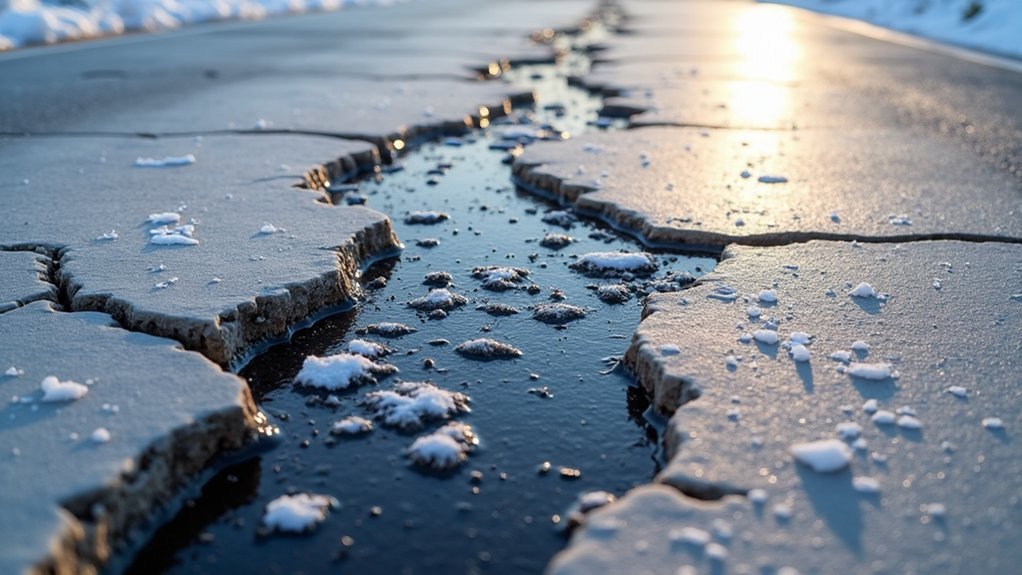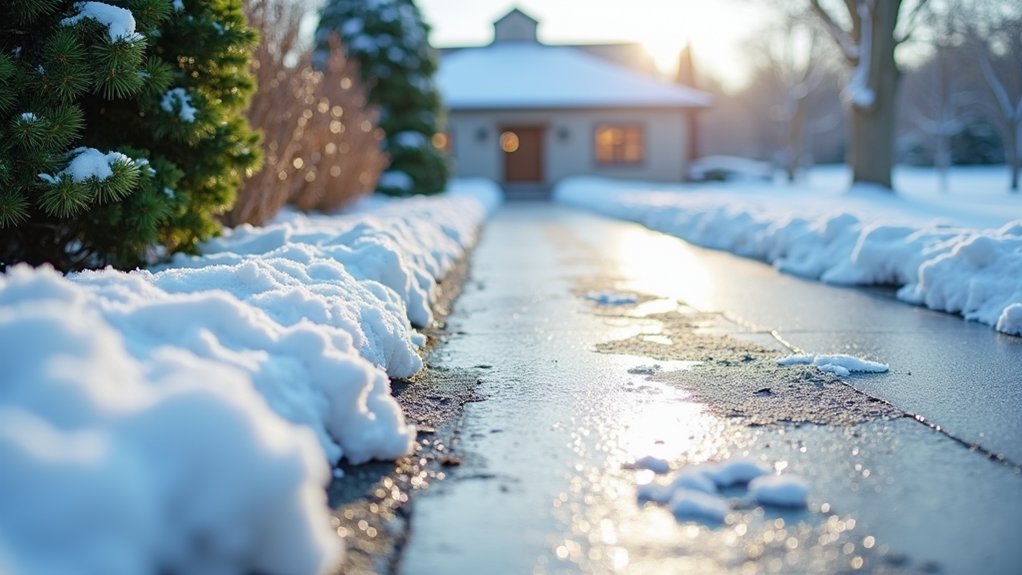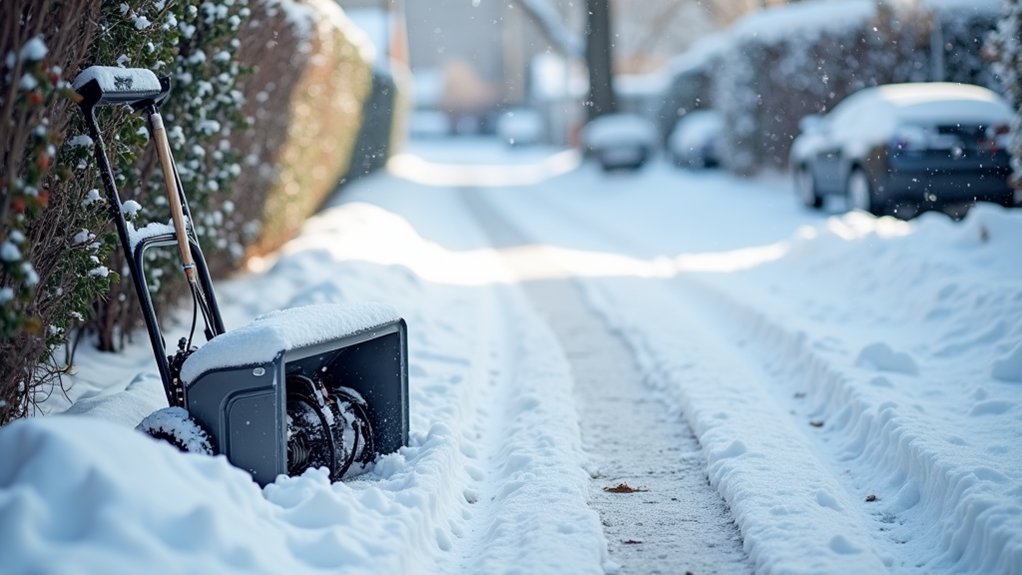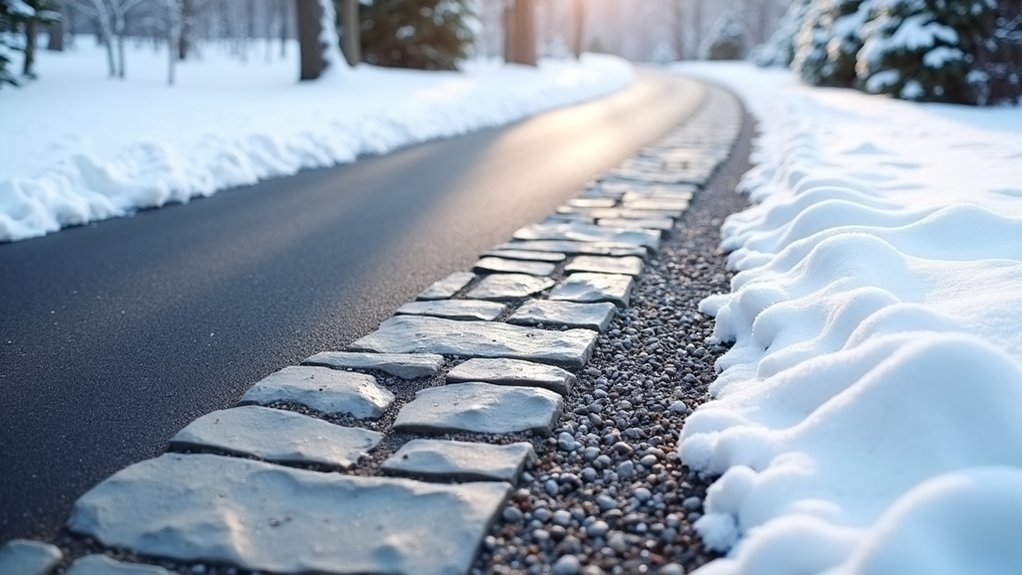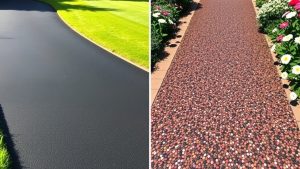Snow and ice can certainly damage your driveway sealant. The freeze-thaw cycle allows water to seep into cracks, expand when frozen, and weaken the sealant. Heavy snowfall adds pressure, leading to microcracks and further deterioration. Additionally, harsh winter chemicals can compromise the sealant’s protective qualities. Ignoring these issues could result in costly repairs later on. Staying informed about maintenance techniques is essential for preserving your driveway’s integrity. It’s important to know how to protect your driveway this winter!
Table of Contents
ToggleKey Takeaways
Snow and ice can cause sealant to peel due to the freeze-thaw cycles that weaken its bond with the pavement. The weight of heavy snow can create microcracks, worsening existing damage and compromising the sealant’s strength. When ice seeps into cracks, it expands, which can lead to the sealant losing its grip and protective qualities. Additionally, de-icing chemicals can increase water infiltration, making the sealant more susceptible to freeze-thaw damage. To keep your driveway in good condition and extend the life of the sealant, regular maintenance such as snow removal is essential.
Understanding the Effects of Freeze-Thaw Cycles
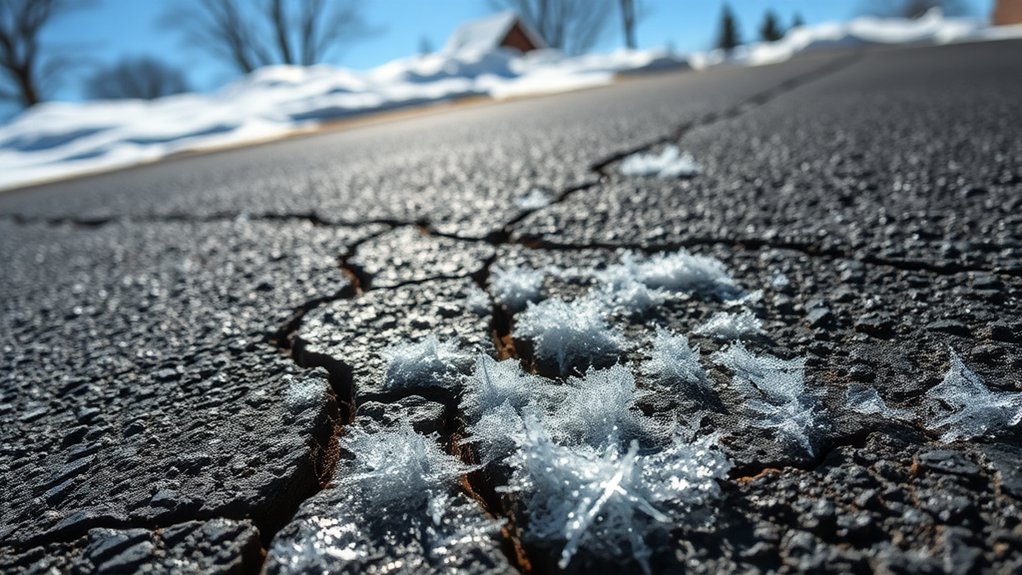
When water seeps into concrete driveways, freeze-thaw cycles can seriously damage their integrity. These cycles occur when water freezes and expands, putting pressure on the concrete. This pressure can lead to cracks and surface spalling, weakening the concrete. Additionally, the freeze-thaw cycle can significantly weaken concrete over time, leading to more severe structural issues. As the ice melts, it contracts, creating voids that can fill with water, perpetuating a cycle of damage. Over time, you might see potholes, scaling, and uneven surfaces due to repeated freeze-thaw stress. To combat these effects, consider sealing your driveway to prevent water infiltration and maintain its structural integrity. Regular maintenance can significantly minimise the impact of freeze-thaw cycles, ensuring your driveway stays durable and functional for years to come. Properly installed tarmac driveways can endure heavy traffic and diverse weather conditions, making them a worthy investment for homeowners.
How Ice Penetrates Sealant and Weakens Protection
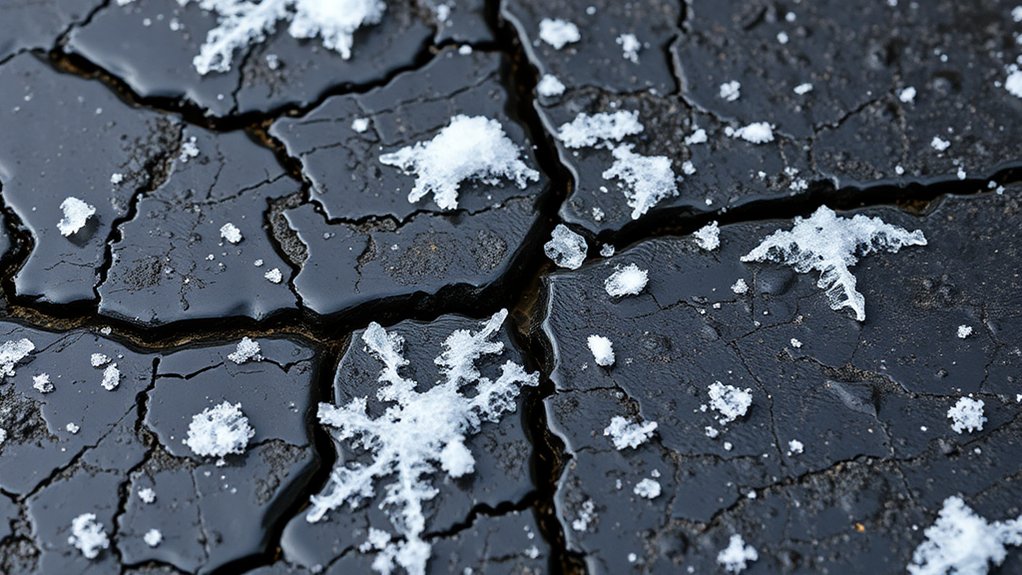
Ice can easily infiltrate your driveway sealant through small cracks and imperfections, causing significant damage. When water seeps in and freezes, it expands, putting pressure on the sealant and weakening its grip and protective qualities. This cycle of freezing and thawing can create gaps over time, leaving your driveway at risk of further deterioration. Proper asphalt pavement preparation before sealcoating can help reduce the likelihood of these cracks forming in the first place.
Ice Infiltration Mechanism
As water seeps into the tiny cracks and pores of driveway sealant, it can cause serious damage when temperatures drop. This water infiltration weakens the sealant, particularly during freeze-thaw cycles.
When water freezes, it expands by about 9%, putting pressure on the sealant and compromising its integrity. Each freeze can cause further damage, creating more cracks that allow even more water to enter. As this cycle continues, the freeze damage speeds up surface deterioration and the spread of cracks. Additionally, the importance of sealcoating is underscored as it acts as a barrier against water, oils, and UV rays, helping to mitigate these issues. Regular maintenance can significantly enhance the lifespan of your driveway sealant, preventing the need for costly repairs.
Furthermore, road salts can lower the freezing point of water, making it easier for moisture to reach deeper layers. Ultimately, this ongoing process undermines your driveway’s protective barrier, leaving it more susceptible to wear and tear.
Sealant Adhesion Weakening
The continual freeze-thaw cycles not only worsen surface damage but also significantly weaken the adhesion of sealant to your driveway.
Ice seeps into tiny cracks, expands, and causes the sealant to peel away, shortening its lifespan.
Here are some crucial factors affecting adhesion:
- Temperature Variations: Sudden temperature changes can put stress on the sealant-pavement bond, leading to loss of adhesion.
- Quality of Sealant: Premium sealants are more resistant to cracking and maintain better adhesion under stress.
- Pre-existing Damage: Cracks and potholes allow water to infiltrate the sealant interface, speeding up deterioration.
- Curing Conditions: Cold weather can hinder proper curing, resulting in a porous layer that’s more susceptible to ice damage.
Additionally, understanding freeze-thaw cycles is essential for maintaining the integrity of the sealant and preventing premature failure.
The Role of Snow Weight in Driveway Deterioration
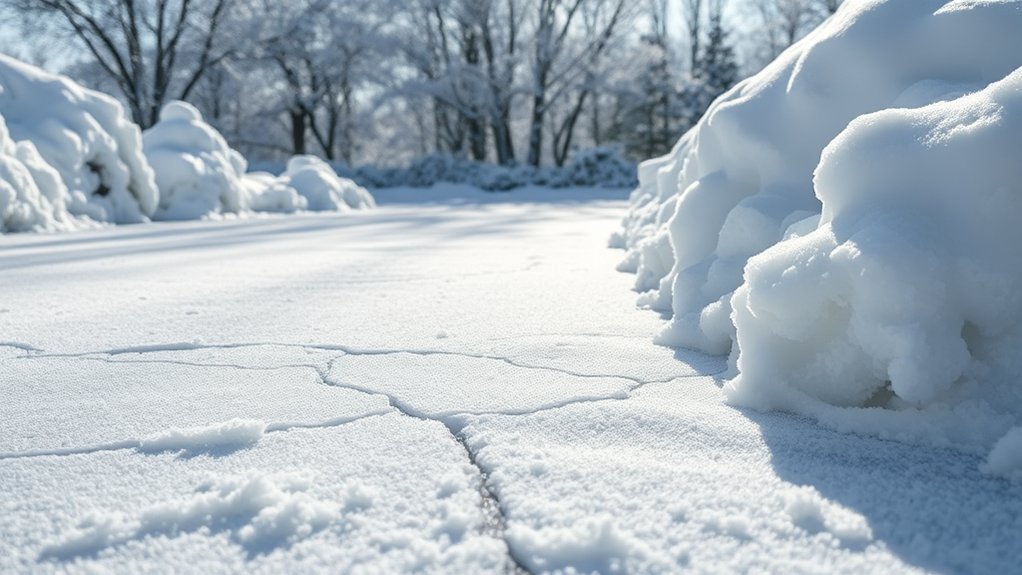
When heavy snow builds up on your driveway, it puts considerable pressure on the surface, leading to various deterioration problems. The weight of the snow can create microcracks, exacerbate existing cracks, and cause surface spalling, which ultimately undermines the performance of sealants. Extended snow cover traps moisture, heightening the risk of sealant breakdown and freeze-thaw damage.
| Snow Weight Effects | Sealant Performance | Consequences |
|---|---|---|
| Microcracks | Reduced flexibility | Surface deformation |
| Surface spalling | Loss of adhesion | Shortened lifespan |
| Moisture retention | Sealant softening | Increased deterioration |
To illustrate, think of your driveway like a sponge. When it absorbs too much weight and moisture, it becomes prone to cracks and wear, similar to how a sponge breaks down when over-saturated. Keeping your driveway clear of heavy snow can help maintain its integrity and extend its lifespan.
Impact of Harsh Winter Chemicals on Sealant Integrity
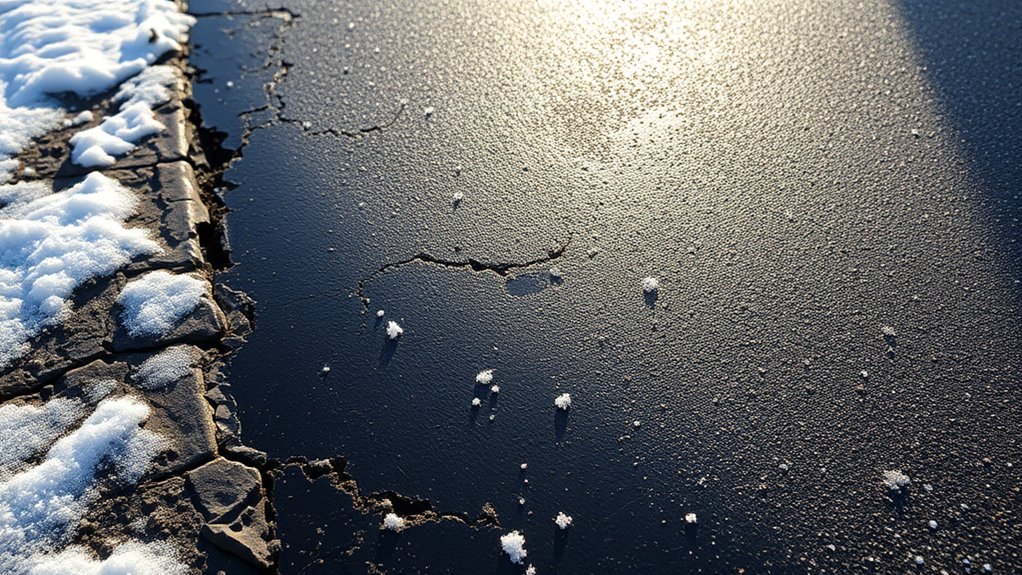
Heavy snowfall can jeopardise your driveway’s integrity, but it’s not just the weight of the snow that causes harm.
Harsh winter chemicals can significantly affect the integrity of sealants, reducing their lifespan and chemical resistance.
Here are four key factors to consider:
- Corrosiveness: Sodium chloride and other de-icing agents can degrade sealants, undermining their protective barrier.
- Freeze-Thaw Cycles: The use of these chemicals can increase freeze-thaw cycles, leading to cracks and surface damage.
- Chemical Reactions: De-icing agents can instigate reactions that weaken the bonds between asphalt and sealants, causing brittleness.
- Infiltration: These chemicals can promote greater water infiltration, making your driveway more vulnerable to damage.
To safeguard your driveway, be mindful of the chemicals you apply and consider using more eco-friendly alternatives.
Regular maintenance is essential to keep your sealant effective.
Protective Benefits of Sealant Against Winter Elements
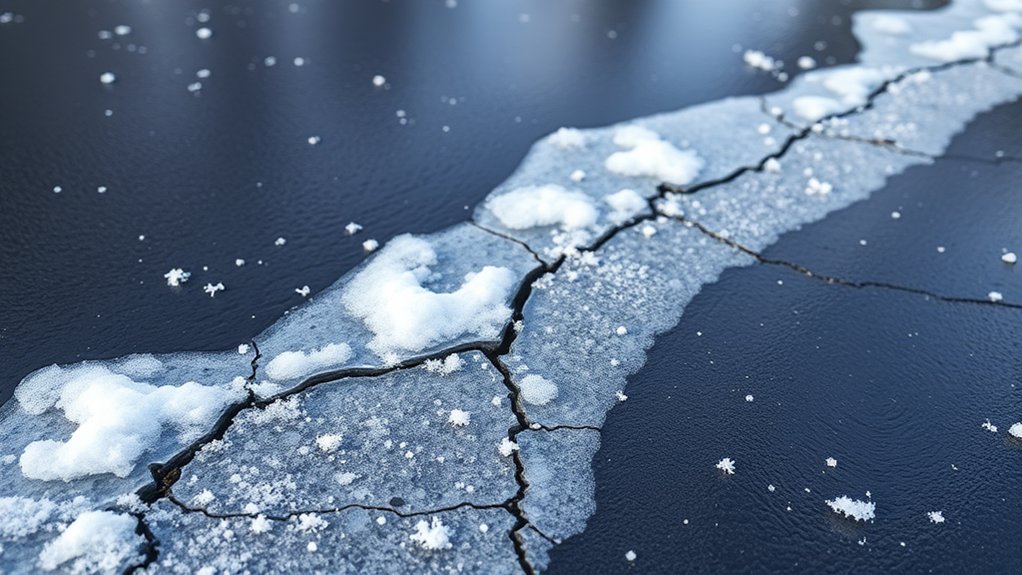
Winter can be harsh on driveways, but applying sealant offers vital protection to help you safeguard your investment.
Sealant creates a water-resistant barrier that prevents water from penetrating and causing freeze-thaw damage, which can lead to cracks and erosion. It also helps snow and ice melt faster, reducing the wear from scraping and lessening the stress from freeze-thaw cycles.
Furthermore, sealant protects against harmful UV rays, helping to maintain the quality of both asphalt and concrete. By improving durability and appearance, sealant not only protects your driveway but also extends its lifespan.
Investing in sealant for winter protection can save you money in the long run and keep your driveway looking good during tough weather.
Best Practices for Snow and Ice Removal
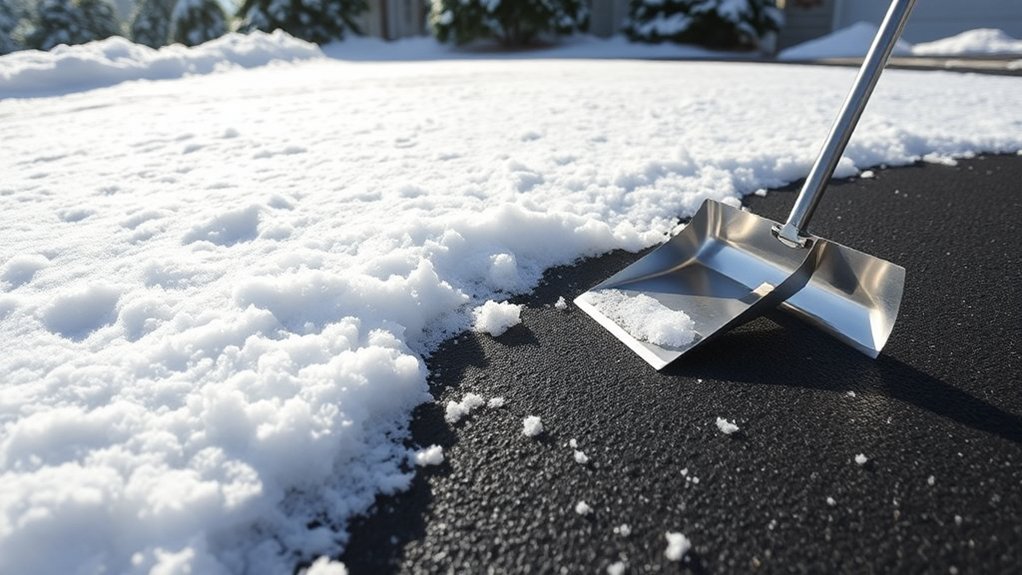
After sealing your driveway, it’s crucial to know how to effectively remove snow and ice to keep it in good condition throughout winter.
Here are some best practices for managing snow and ice:
- Shovel regularly: Clear snow after every 5 cm (2 inches) to stop heavy build-up and prevent ice from bonding.
- Use the right tools: A robust metal shovel works best for driveways, while a plastic one is gentler on decks.
- Apply de-icers carefully: Use rock salt or alternatives like calcium chloride after shovelling to melt any remaining ice without damaging your driveway.
- Manage snow piles: Place them away from your home’s foundation and drainage areas to avoid potential water damage and flooding.
Timing and Frequency for Optimal Sealcoat Application
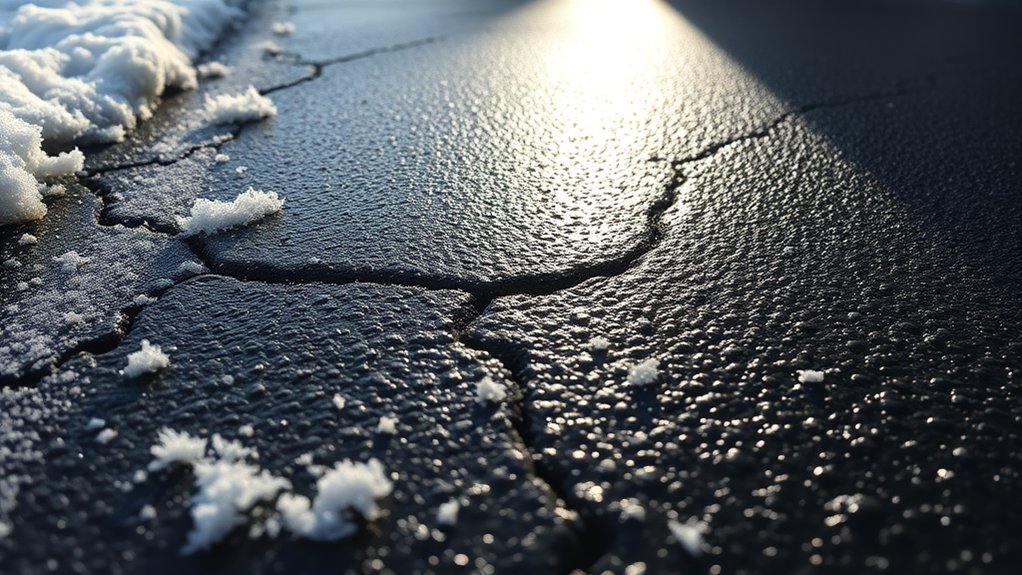
Timing your sealcoat application is crucial to keep your driveway protected and looking good. For residential driveways, aim to sealcoat every 2 to 3 years, while commercial areas may require it annually.
If you’ve recently had asphalt laid, ensure it’s sealed within 6 to 12 months for the best results.
Apply sealant when temperatures are above 10°C (50°F), preferably in late spring or early autumn, and make sure conditions are dry for proper adhesion.
Watch for signs like surface cracking or fading; these indicate it’s time to reapply.
Use correct application techniques and schedule regular inspections to adjust your timing based on traffic levels and environmental conditions, thus enhancing the longevity of your driveway.
Effects of Deicing Chemicals on Driveway Condition
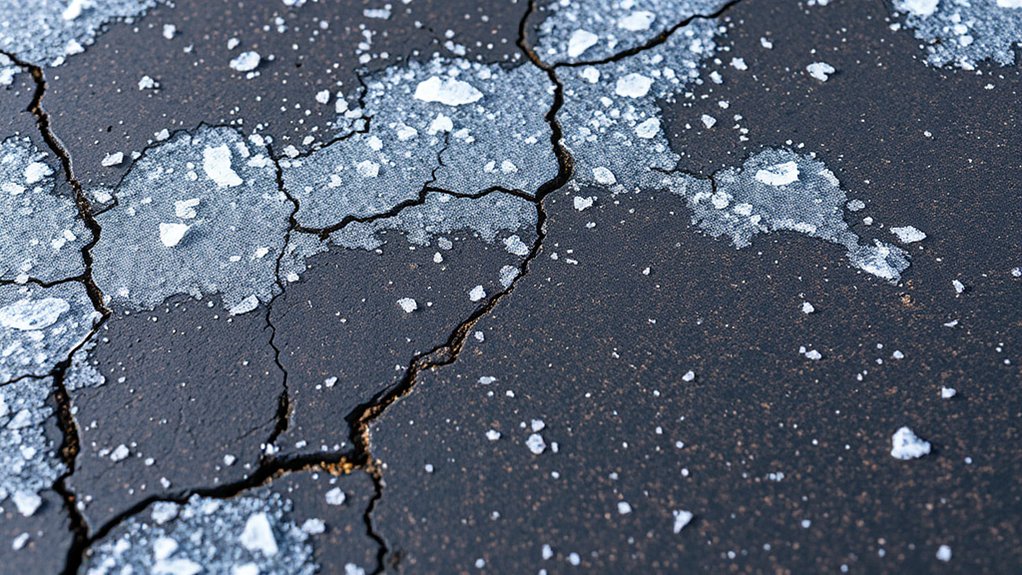
De-icing chemicals can significantly damage your driveway, causing cracks and surface deterioration over time.
Understanding how these substances react with concrete allows you to make better choices about safer alternatives.
Opting for gentler options not only safeguards your driveway but also ensures its durability during harsh winter conditions.
For instance, using salt-free de-icers or sand can help improve traction without harming your driveway.
Impact of Deicing Chemicals
While winter can create a beautiful scene, the use of deicing chemicals can seriously damage your driveway. These substances, mainly chlorides, can cause several problems:
- Chemical Reactions: Calcium chloride can react with concrete, resulting in expansive compounds that deteriorate the surface.
- Surface Damage: Chlorides lower the pH of concrete, leading to chalking and corrosion of any embedded steel.
- Freeze-Thaw Cycles: Deicers trap moisture, increasing the risk of freeze-thaw cycles that result in cracks and scaling.
- Sealant Degradation: Chemicals can penetrate sealants, compromising their protective layer and allowing moisture to cause further harm.
Opting for safer deicing alternatives can help avoid these damaging effects and preserve your driveway through the winter months.
Recommended Safer Alternatives
To keep your driveway in top shape during winter, it’s important to choose safer alternatives to traditional de-icing chemicals. Sand or gravel can be used as traction agents; they’re non-corrosive and won’t damage your sealants.
Calcium Magnesium Acetate (CMA) is another effective choice, as it’s biodegradable and gentler on your driveway’s surface. Potassium acetate-based de-icers are also good options, minimising the risk of damaging sealants while being kind to the environment.
If you’re prepared to make an upfront investment, heated driveway systems can eliminate the need for any chemicals altogether, ensuring your driveway lasts longer.
Additionally, opt for water-based sealants that can endure freeze-thaw cycles and work well with safer de-icers, further protecting your investment. Following these tips will help maintain your driveway’s integrity throughout the winter months.
Consequences of Not Sealing Driveways Before Winter
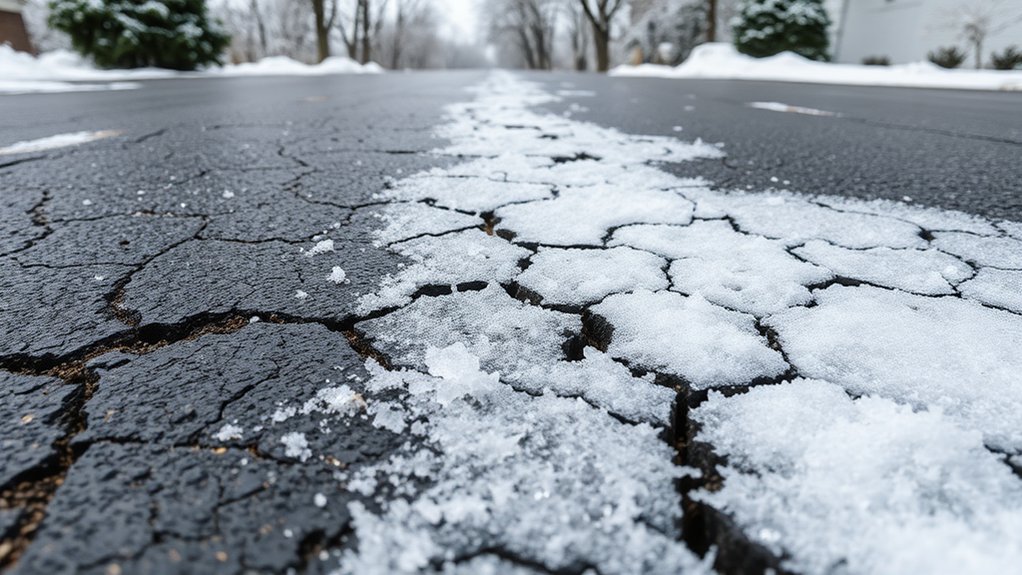
Neglecting to seal your driveway before winter can lead to a series of problems that affect both its durability and appearance.
Here are some key issues you might encounter:
- Increased Water Infiltration: Water can seep into cracks, freeze during cold spells, and expand, causing further damage.
- Accelerated Crack Formation: Small cracks can quickly grow larger, resulting in potholes and surface deterioration.
- Higher Repair Costs: You may end up facing costly repairs or even the need for a complete replacement as the damage worsens.
- Negative Driveway Aesthetics: Visible cracks and uneven surfaces can detract from your property’s curb appeal and potentially lower its value.
Taking the time to seal your driveway can help you avoid these issues and save you money in the long run.
Maintaining Driveway Health Through Regular Maintenance
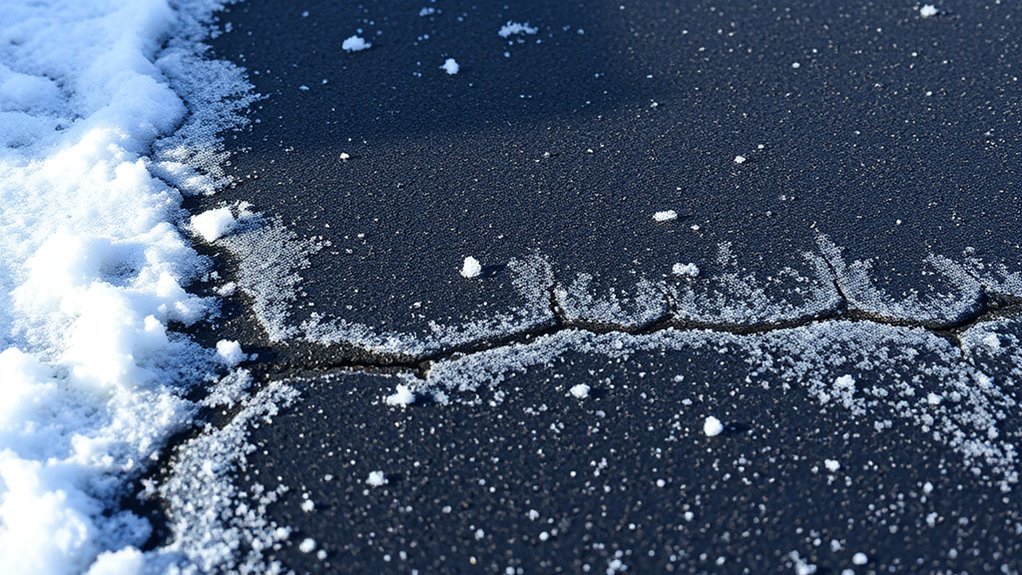
Maintaining your driveway is vital for its longevity, particularly through the tough winter months. Regular cleaning and inspection are key. Clear away debris with a broom or blower, and check for cracks or worn sealant at least once a year.
Tackle spills immediately to prevent staining. When it snows, use a plastic shovel to protect the sealant. Avoid harsh de-icing chemicals; instead, choose non-corrosive alternatives.
For sealant upkeep, apply a new layer every 2 to 3 years in dry, warm weather. Always fix cracks before sealing and ensure everything dries properly.
Following these steps will keep your driveway sturdy and looking good all year round.
Frequently Asked Questions
Can Driveway Sealant Be Applied During Winter Months?
You shouldn’t apply driveway sealant during the winter months. Cold temperatures significantly affect the performance of the sealant, resulting in weak adhesion and a higher risk of damage. It’s best to wait for warmer weather to ensure effective sealing.
How Does Humidity Affect the Longevity of Driveway Sealant?
Humidity can hinder the drying and curing of your driveway sealant. High moisture levels delay the process, which can compromise the sealant’s durability and lead to issues such as peeling or cracking. To ensure your driveway remains protected against wear and tear, it’s essential to consider humidity levels when applying sealant.
What Are Signs of Sealant Damage After Winter?
After winter, you may spot cracks, flaking, or sunken patches on your driveway. Regular winter maintenance can enhance the durability of your sealant, so keep an eye out for uneven surfaces or areas where water pools. Addressing these issues early can save you from expensive repairs later on.
Can Sealant Be Reapplied Over Existing Layers?
Yes, you can reapply sealant over existing layers if they are in good condition. Check for cracks, clean the surface thoroughly, and apply the sealant evenly. This helps protect your driveway and can extend its lifespan effectively.
Is It Necessary to Seal New Driveways Before Winter?
Sealing new driveways before winter is crucial for proper preparation and protection. It helps prevent water from seeping in, which can lead to freeze-thaw damage. This not only enhances the durability of your driveway but also keeps it looking good during the colder months. For example, if water gets into cracks and freezes, it can cause those cracks to expand and worsen over time. Therefore, sealing your driveway is a smart move to ensure it lasts longer and stays in good condition.
Conclusion
To protect your driveway from the damaging effects of snow and ice, it’s essential to apply sealant properly before winter. Sealing your surface will shield it from harsh weather, preventing water penetration and potential issues. Regular maintenance and careful use of de-icing chemicals can further strengthen your driveway’s resilience. Don’t let winter weather deteriorate your investment—stay proactive and maintain your driveway for a strong and appealing surface all year round!
Be proactive in protecting your driveway from cold weather cracks by learning essential sealing techniques that could save you costly Read more
Achieve a pristine tarmac driveway this winter—discover the best snow removal methods that will keep your surface safe and clear.
Uncover the ideal driveway material for frigid temperatures and discover which option can withstand winter's harshest challenges effectively.

